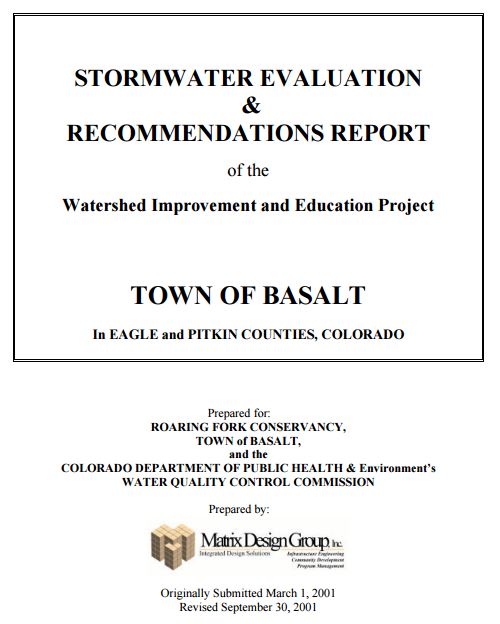1.1 Acknowledgement
The Roaring Fork Conservancy’s (Conservancy) mission is to protect and enhance the streams and rivers within the Roaring Fork River watershed. The agency is involved in initiatives to measure the health of the Roaring Fork River, enhance riparian and aquatic habitat, and lead environmental programs. Stormwater runoff can have a major impact on the stream system, and therefore, the Conservancy is interested in better management of water quality from urban stormwater runoff.
The Conservancy applied to the Colorado Water Quality Control Commission for a grant to evaluate non-point source pollution and develop an education project on the stormwater impacts to water quality in the Basalt area. The State of Colorado awarded the Roaring Fork Conservancy a Grant under Section 319 of the Federal Clean Water Act on August 16, 1999. The Conservancy formed a partnership with the Town of Basalt on October 15, 1999 to develop a cooperative relationship for evaluation of stormwater runoff sources for quality and composition. The resulting Watershed Improvement and Education Project has two main components:
1. Evaluation of non-point source pollutants and developing recommendations for implementation of “Best Management Practices” (BMPs) in the Town of Basalt, and
2. Expansion of educational activities to include water quality monitoring programs, water quality analysis, and public outreach focused on preventative strategies to minimize soil erosion and stormwater runoff.
This grant will provide the means to develop a paradigm for educating the community on stormwater controls, and ultimately help to protect the vital water quality of the River. This project is designed to educate not only the Basalt community, but also other small mountain communities in the Roaring Fork Valley and other Western Slope watersheds.
This Watershed Improvement and Education Project is supported by the Roaring Fork RE-1 School District, Pitkin County, Roaring Fork Outdoor Volunteers, the Roaring Fork Chapter of the Audubon Society, the Roaring Fork Bioinventory Project, the Aspen Center for Environmental Studies, the Aspen Wilderness Workshop, the Roaring Fork Watershed Coalition, the Colorado Division of Wildlife, the Colorado Department of Transportation, the Aspen Ski Company Environmental Foundation, Trout Unlimited and the Basalt Beautification Committee.
1.2 Background
Basalt’s concerns with stormwater have been typically related to local flooding. Residents complain when mud washes down the hillside, their basements flood, utilities are washed away, or roads become impassable. The community suffers when severe catastrophic floods cause widespread damage to property and loss of life. However, few people are keenly aware of the water quality impacts that stormwater has on the rivers, streams, and lakes. Stormwater runoff can have significant impacts on the receiving waters of the Roaring Fork and Fryingpan Rivers that run through the heart of town by affecting water quality and the aquatic ecosystem.
Many people are familiar with the environmental impacts from municipal and industrial wastewater discharges; however, few are aware of the environmental impacts attributable to ordinary stormwater runoff from urban areas. Studies have shown that runoff from development can contain significant quantities of the same general types of constituents that are found in wastewater and industrial discharges.
The impacts of stormwater on streams fit into four general categories:
1. Stream Hydrology: Urban development affects the environment through changes in the size and frequency of storm runoff events, changes in base flows of the stream, and changes in stream flow velocities during storms. Peak discharges into a stream can increase from urbanization due to a decrease in infiltration of rainfall into the ground, and loss of buffering vegetation and resultant reduced evapotranspiration. This results in more surface runoff and larger loads of various pollutants found in urban stormwater
2. Stream Morphology: When the hydrology of the stream changes, it results in changes to the physical characteristics of the stream. Such changes include streambed degradation, stream widening, and streambank erosion. As the stream profile degrades and the stream tries to widen to accommodate higher flows, bank erosion increases along with increases in sediment loads.
3. Stream Water Quality: Water quality is impacted through urbanization as a result of erosion during construction, changes in stream morphology, and transport of accumulated deposits from the urban landscape into the river. Water quality problems include turbid water, nutrient enrichment, bacterial contamination, organic matter loads, metals, salts, temperature increases, and increased trash and debris.
4. Aquatic Ecology: Pollutant loading from stormwater runoff can significantly alter aquatic ecology, and if left untreated, could diminish aquatic conditions to a level that would threaten the Roaring Fork River’s “Gold Medal” fishery classification.
Urbanization affects stormwater runoff by increasing the following:
- The volumes and rates of surface runoff,
- The concentrations and the types of pollutants,
- The amount of pollutants carried to receiving waters.
Urbanization causes a reduction in open land areas, an increase in impervious areas, and accelerated surface runoff (which reduces flooding around development, but increases downstream riverine flooding and reduces water quality). The influx of commercial, residential, and industrial products into an urban area such as Basalt often brings new pollutants that result in increased concentrations of these pollutants in stormwater. Additional impervious areas can make pollutants easier to wash off the surface and quicken their conveyance through the watershed. The cumulative effect results in much larger loads, and in the delivery of certain pollutants, such as petroleum-based products, not normally found in non-urban and nonindustrial runoff.
